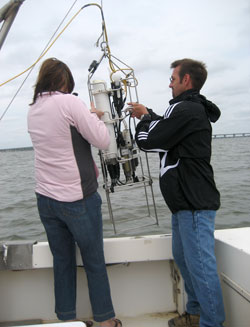 Introduction
Introduction
Lakes, estuaries, and oceans are nature’s examples of how different water densities separate. When scientists conduct vertical profiles through a water column, they can determine if there is mixing of top water and bottom water through analysis of temperature, salinity and oxygen readings through the vertical gradient. If these parameters are the same throughout the depth of the water column, then the water is well mixed. However, if there are differences (e.g. more dense, cooler higher salinity, water toward the bottom) from top to bottom, then the water column is termed stratified, or not well mixed. Whether or not the water column is mixed has strong implications for organisms living in this environment. For example, the main source of oxygen to bottom water is from mixing with surface water, which is in direct contact with the air. If there is no mixing, oxygen is depleted from the bottom water and organisms will either move or die.
The purpose of the field investigation is to determine if water is mixed or stratified through vertical measurements of temperature, salinity and oxygen. As many classrooms are likely unable to take a boat trip, data from a vertical profile in Maryland's Choptank River, a tributary to the Chesapeake Bay, is available to download in the Lesson Resources section. In a companion web-based activity, we will compare these field data with those data from observing systems and assess the advantages and disadvantages of the two methods of data collection.
Objective
To determine if the water is vertically mixed or stratified.
Materials
- Data sheets
- Computer with Internet connection
- Boat, Oxygen, Temperature, Salinity meter with 30 meter cable OR Vertical Profile Dataset (download below)
Procedure
Field Investigation:
- Select a station in a body of water with a depth of at least 10 meters and record latitude and longitude. Observe weather conditions and record on data sheet.
- Using the instrument that measures temperature, salinity and oxygen, lower the probe through the water column taking measurements at 1 meter intervals.
- Record salinity/conductivity, temperature and oxygen in the data table in the Student Worksheet.
Web-based Investigation:
- Select a location from one of the Web Links listed below with buoys reporting salinity and temperature from at least 2 different depths.
- Record observations for salinity and temperature at the surface, at a middle depth, and at the deepest depth in the data table on the Student Worksheet.
- Answer the following questions:
Which method of data acquisition provided a more comprehensive view of vertical mixing/stratification at the time of sampling?
Which method provided a better long term analysis of mixing/stratification over time?
Which method would you use if…
- You wanted to know if the water in the estuary was stratified at a certain depth?
- You wanted to predict if there was going to be a turn-over event in the river?
- You wanted to see if there might be a fish kill caused by low oxygen bottom waters?
Web Links
- Northeast http://www.gomoos.com/
- Southeast http://carocoops.org/carocoops_website/index.php
- Southern California http://www.sccoos.org/
- Great Lakes http://www.glerl.noaa.gov/res/glcfs/
Lesson Resources
Vertical Profile Dataset